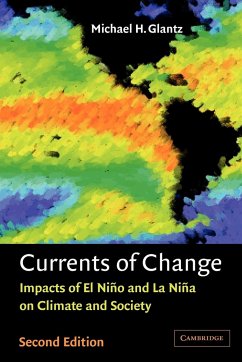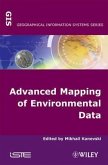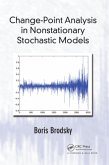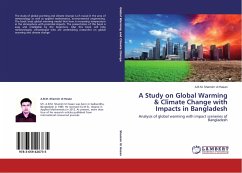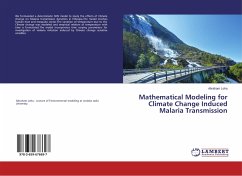- Broschiertes Buch
- Merkliste
- Auf die Merkliste
- Bewerten Bewerten
- Teilen
- Produkt teilen
- Produkterinnerung
- Produkterinnerung
Explores in simple terms the effects and ramifications of El Nino and La Nina events.
Andere Kunden interessierten sich auch für
![Flows of Non-Smooth Vector Fields and Degenerate Elliptic Equations Flows of Non-Smooth Vector Fields and Degenerate Elliptic Equations]() Maria ColomboFlows of Non-Smooth Vector Fields and Degenerate Elliptic Equations24,99 €
Maria ColomboFlows of Non-Smooth Vector Fields and Degenerate Elliptic Equations24,99 €![Advanced Mapping of Environmental Data Advanced Mapping of Environmental Data]() Advanced Mapping of Environmental Data223,99 €
Advanced Mapping of Environmental Data223,99 €![Nonlinear Evolution Equations That Change Type Nonlinear Evolution Equations That Change Type]() Barbara L. Keyfitz / Michael Shearer (eds.)Nonlinear Evolution Equations That Change Type148,99 €
Barbara L. Keyfitz / Michael Shearer (eds.)Nonlinear Evolution Equations That Change Type148,99 €![Change-Point Analysis in Nonstationary Stochastic Models Change-Point Analysis in Nonstationary Stochastic Models]() Boris BrodskyChange-Point Analysis in Nonstationary Stochastic Models51,99 €
Boris BrodskyChange-Point Analysis in Nonstationary Stochastic Models51,99 €![A Study on Global Warming & Climate Change with Impacts in Bangladesh A Study on Global Warming & Climate Change with Impacts in Bangladesh]() A. B. M. Shamim Ul HasanA Study on Global Warming & Climate Change with Impacts in Bangladesh51,99 €
A. B. M. Shamim Ul HasanA Study on Global Warming & Climate Change with Impacts in Bangladesh51,99 €![Platform for Change Platform for Change]() Stafford BeerPlatform for Change132,99 €
Stafford BeerPlatform for Change132,99 €![Mathematical Modeling for Climate Change Induced Malaria Transmission Mathematical Modeling for Climate Change Induced Malaria Transmission]() Abraham LohaMathematical Modeling for Climate Change Induced Malaria Transmission28,99 €
Abraham LohaMathematical Modeling for Climate Change Induced Malaria Transmission28,99 €-
-
-
Explores in simple terms the effects and ramifications of El Nino and La Nina events.
Hinweis: Dieser Artikel kann nur an eine deutsche Lieferadresse ausgeliefert werden.
Hinweis: Dieser Artikel kann nur an eine deutsche Lieferadresse ausgeliefert werden.
Produktdetails
- Produktdetails
- Verlag: Cambridge University Press
- Revised
- Seitenzahl: 268
- Erscheinungstermin: 10. Januar 2011
- Englisch
- Abmessung: 229mm x 152mm x 16mm
- Gewicht: 440g
- ISBN-13: 9780521786720
- ISBN-10: 052178672X
- Artikelnr.: 21463645
- Herstellerkennzeichnung
- Libri GmbH
- Europaallee 1
- 36244 Bad Hersfeld
- gpsr@libri.de
- Verlag: Cambridge University Press
- Revised
- Seitenzahl: 268
- Erscheinungstermin: 10. Januar 2011
- Englisch
- Abmessung: 229mm x 152mm x 16mm
- Gewicht: 440g
- ISBN-13: 9780521786720
- ISBN-10: 052178672X
- Artikelnr.: 21463645
- Herstellerkennzeichnung
- Libri GmbH
- Europaallee 1
- 36244 Bad Hersfeld
- gpsr@libri.de
Michael H. Glantz was a Senior Scientist at the National Center for Atmospheric Research (NCAR), where he researched from 1974 to 2009. Since then, he has been the director of the University of Colorado's Consortium for Capacity Building (CCB). His research publications relate to understanding how extreme climate, water and weather affect societies and how societies affect climate. Since 1976, Glantz has conducted joint research in the former Soviet Union and in the Central Asian Republics on desertification and on the disappearing of the Aral Sea. In 2013 he was recognized by China as a pioneer in desertification studies. Glantz is a member of the Advisory Committee of the international Integrated Risk Governance Program, headquartered at Beijing Normal University. He has lectured on the Climate Affairs concept in several Chinese cities at universities and meteorological centers. He has numerous publications on climate, water and weather issues. Glantz and Professor Qian (BNU and executive director of the IRG) co-authored Usable Thoughts: Climate, Water and Weather in the 21st Century. His current multiyear research is "El Niño Ready Nations," supported by USAID/OFDA. Many Belt and Road countries are affected by El Niño's impacts. In 1990 he received the Global 500 Award of the UN Environment Program (UNEP) that recognizes people working in diverse ways to protect and enhance the planet's natural resources. Glantz received the 2009 Clinton Global Initiative and Rockefeller Foundation Commitment. He has a BS in Metallurgical Engineering (1961) and an MA (1963) and PhD (1970) in Political Science/ International Relations from the University of Pennsylvania.
Acknowledgements
Preface to second edition
Preface to first edition
1. Introduction
2. El Niño
3. A tale of two histories
4. The biography of El Niño
5. The biography of La Niña
6. The 1982-1983 El Niño: a case of an anomalous anomaly
7. Forecasting El Niño
8. Forecasting the 1997-1998 El Niño
9. Teleconnections
10. El Niño's ecological impacts: The Galapagos
11. Methods used to identify El Niño
12. El Niño and health
13. The media, El Niño and La Niña: a study in media-rology
14. Why do ENSO events continue to surprise us?
15. What people need to know about El Niño
16. Usable science
Appendix
References.
Preface to second edition
Preface to first edition
1. Introduction
2. El Niño
3. A tale of two histories
4. The biography of El Niño
5. The biography of La Niña
6. The 1982-1983 El Niño: a case of an anomalous anomaly
7. Forecasting El Niño
8. Forecasting the 1997-1998 El Niño
9. Teleconnections
10. El Niño's ecological impacts: The Galapagos
11. Methods used to identify El Niño
12. El Niño and health
13. The media, El Niño and La Niña: a study in media-rology
14. Why do ENSO events continue to surprise us?
15. What people need to know about El Niño
16. Usable science
Appendix
References.
Acknowledgements
Preface to second edition
Preface to first edition
1. Introduction
2. El Niño
3. A tale of two histories
4. The biography of El Niño
5. The biography of La Niña
6. The 1982-1983 El Niño: a case of an anomalous anomaly
7. Forecasting El Niño
8. Forecasting the 1997-1998 El Niño
9. Teleconnections
10. El Niño's ecological impacts: The Galapagos
11. Methods used to identify El Niño
12. El Niño and health
13. The media, El Niño and La Niña: a study in media-rology
14. Why do ENSO events continue to surprise us?
15. What people need to know about El Niño
16. Usable science
Appendix
References.
Preface to second edition
Preface to first edition
1. Introduction
2. El Niño
3. A tale of two histories
4. The biography of El Niño
5. The biography of La Niña
6. The 1982-1983 El Niño: a case of an anomalous anomaly
7. Forecasting El Niño
8. Forecasting the 1997-1998 El Niño
9. Teleconnections
10. El Niño's ecological impacts: The Galapagos
11. Methods used to identify El Niño
12. El Niño and health
13. The media, El Niño and La Niña: a study in media-rology
14. Why do ENSO events continue to surprise us?
15. What people need to know about El Niño
16. Usable science
Appendix
References.

